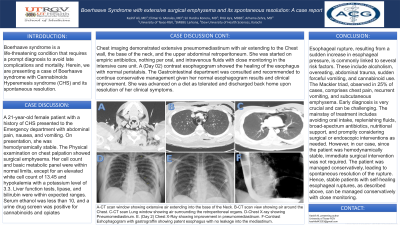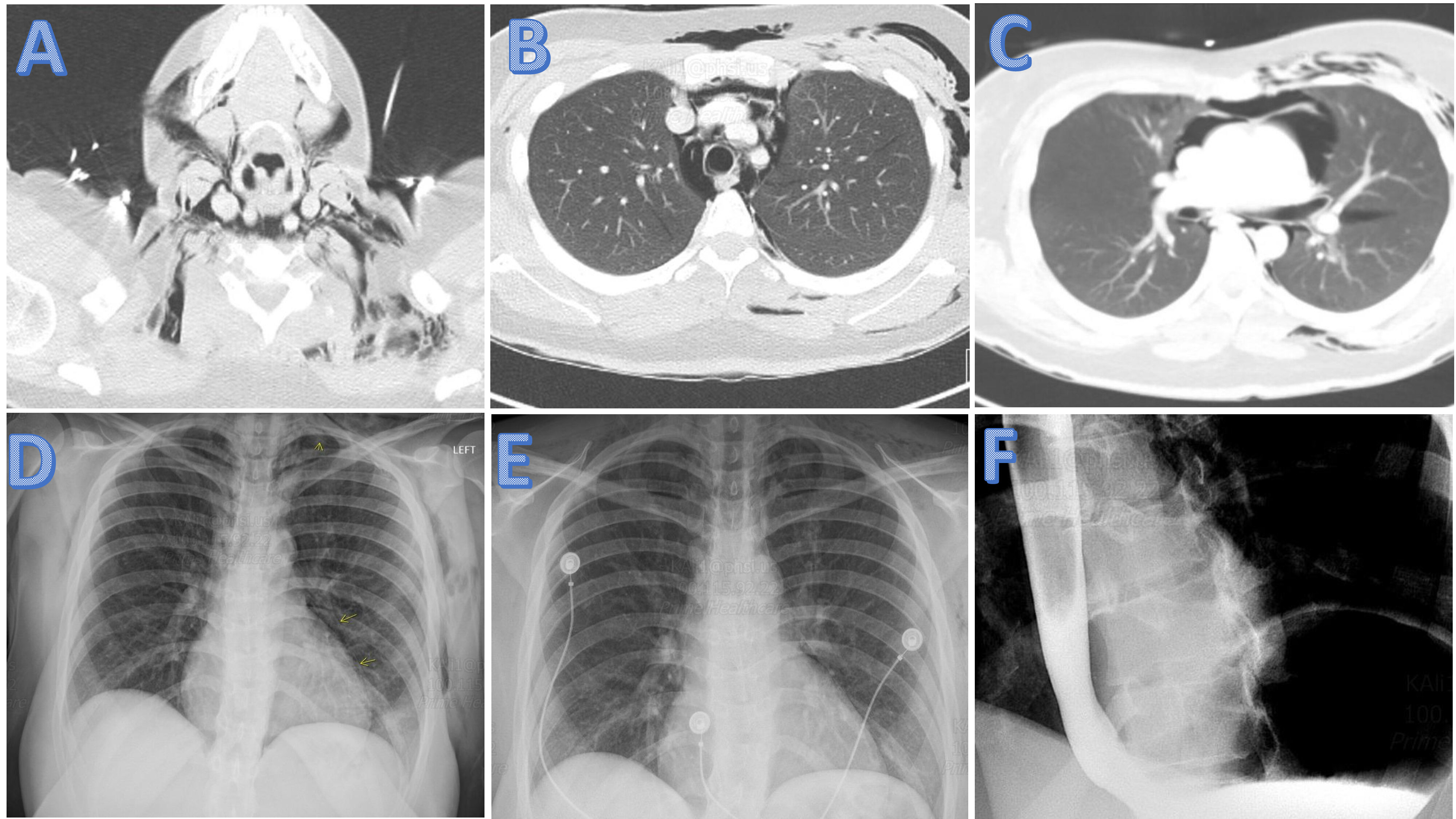Tuesday Poster Session
Category: Esophagus
P3958 - Boerhaave Syndrome with Extensive Surgical Emphysema and its Spontaneous Resolution: A Case Report
Tuesday, October 29, 2024
10:30 AM - 4:00 PM ET
Location: Exhibit Hall E

Has Audio

Kashif Ali, MD
University of Texas Rio Grande Valley
Edinburg, TX
Presenting Author(s)
Kashif Ali, MD1, Elimar Gonzalez Morales, MD2, Sri Harsha Koneru, MD2, Fnu Iqra, MBBS3, Arhama Zehra, MD4
1University of Texas Rio Grande Valley, Edinburg, TX; 2University of Texas Rio Grande Valley, Weslaco, TX; 3Shaheed Mohtarma Benazir Bhutto Medical University, Larkana, Sindh, Pakistan; 4Dow Medical College, O'Fallon, IL
Introduction: Boerhaave syndrome is a life-threatening condition that requires a prompt diagnosis to
avoid late complications and mortality. Herein, we are presenting a case of Boerhaave
syndrome with Cannabinoids Hyperemesis syndrome (CHS) and its spontaneous
resolution.
Case Description/Methods: A 21-year-old female patient with a history of CHS presented to the Emergency
department with abdominal pain, nausea, and vomiting. On presentation, she was
hemodynamically stable. The Physical examination on chest palpation showed surgical
emphysema. Her cell count and basic metabolic panel were within normal limits, except for
an elevated white cell count of 13.45 and hypokalemia with a potassium level of 3.3. Liver
function tests, lipase, and bilirubin were within expected ranges. Serum ethanol was less
than 10, and a urine drug screen was positive for cannabinoids and opiates. Chest imaging
demonstrated extensive pneumomediastinum with air extending to the Chest wall, the base
of the neck, and the upper abdominal retroperitoneum. She was started on empiric
antibiotics, nothing per oral, and intravenous fluids with close monitoring in the intensive
care unit. A (Day 02) contrast esophagogram showed the healing of the esophagus with
normal peristalsis. The Gastrointestinal department was consulted and recommended to
continue conservative management given her normal esophagogram results and clinical
improvement. She was advanced on a diet as tolerated and discharged back home upon
resolution of her clinical symptoms.
Discussion: Esophageal rupture, resulting from a sudden increase in esophageal pressure, is commonly
linked to several risk factors. These include alcoholism, overeating, abdominal trauma,
sudden forceful vomiting, and cannabinoid use. The Mackler triad, observed in 25% of
cases, comprises chest pain, recurrent vomiting, and subcutaneous emphysema. Early
diagnosis is very crucial and can be challenging. The mainstay of treatment includes
avoiding oral intake, replenishing fluids, broad-spectrum antibiotics, nutritional support,
and promptly considering surgical or endoscopic interventions as needed. However, in our
case, since the patient was hemodynamically stable, immediate surgical intervention was
not required. The patient was managed conservatively, leading to spontaneous resolution
of the rupture. Hence, stable patients with self-healing esophageal ruptures, as described
above, can be managed conservatively with close monitoring.

Disclosures:
Kashif Ali, MD1, Elimar Gonzalez Morales, MD2, Sri Harsha Koneru, MD2, Fnu Iqra, MBBS3, Arhama Zehra, MD4. P3958 - Boerhaave Syndrome with Extensive Surgical Emphysema and its Spontaneous Resolution: A Case Report, ACG 2024 Annual Scientific Meeting Abstracts. Philadelphia, PA: American College of Gastroenterology.
1University of Texas Rio Grande Valley, Edinburg, TX; 2University of Texas Rio Grande Valley, Weslaco, TX; 3Shaheed Mohtarma Benazir Bhutto Medical University, Larkana, Sindh, Pakistan; 4Dow Medical College, O'Fallon, IL
Introduction: Boerhaave syndrome is a life-threatening condition that requires a prompt diagnosis to
avoid late complications and mortality. Herein, we are presenting a case of Boerhaave
syndrome with Cannabinoids Hyperemesis syndrome (CHS) and its spontaneous
resolution.
Case Description/Methods: A 21-year-old female patient with a history of CHS presented to the Emergency
department with abdominal pain, nausea, and vomiting. On presentation, she was
hemodynamically stable. The Physical examination on chest palpation showed surgical
emphysema. Her cell count and basic metabolic panel were within normal limits, except for
an elevated white cell count of 13.45 and hypokalemia with a potassium level of 3.3. Liver
function tests, lipase, and bilirubin were within expected ranges. Serum ethanol was less
than 10, and a urine drug screen was positive for cannabinoids and opiates. Chest imaging
demonstrated extensive pneumomediastinum with air extending to the Chest wall, the base
of the neck, and the upper abdominal retroperitoneum. She was started on empiric
antibiotics, nothing per oral, and intravenous fluids with close monitoring in the intensive
care unit. A (Day 02) contrast esophagogram showed the healing of the esophagus with
normal peristalsis. The Gastrointestinal department was consulted and recommended to
continue conservative management given her normal esophagogram results and clinical
improvement. She was advanced on a diet as tolerated and discharged back home upon
resolution of her clinical symptoms.
Discussion: Esophageal rupture, resulting from a sudden increase in esophageal pressure, is commonly
linked to several risk factors. These include alcoholism, overeating, abdominal trauma,
sudden forceful vomiting, and cannabinoid use. The Mackler triad, observed in 25% of
cases, comprises chest pain, recurrent vomiting, and subcutaneous emphysema. Early
diagnosis is very crucial and can be challenging. The mainstay of treatment includes
avoiding oral intake, replenishing fluids, broad-spectrum antibiotics, nutritional support,
and promptly considering surgical or endoscopic interventions as needed. However, in our
case, since the patient was hemodynamically stable, immediate surgical intervention was
not required. The patient was managed conservatively, leading to spontaneous resolution
of the rupture. Hence, stable patients with self-healing esophageal ruptures, as described
above, can be managed conservatively with close monitoring.

Figure: A-CT scan window showing extensive air extending into the base of the Neck.
B-CT scan view showing air around the Chest.
C-CT scan Lung window showing air surrounding the retroperitoneal organs.
D-Chest X-ray showing Pneumomediastinum.
E. (Day 2) Chest X-Ray showing improvement in pneumomediastinum.
F-Contrast Eshophagogram with gastrograffin showing patent esophagus with no leakage into the mediastinum.
B-CT scan view showing air around the Chest.
C-CT scan Lung window showing air surrounding the retroperitoneal organs.
D-Chest X-ray showing Pneumomediastinum.
E. (Day 2) Chest X-Ray showing improvement in pneumomediastinum.
F-Contrast Eshophagogram with gastrograffin showing patent esophagus with no leakage into the mediastinum.
Disclosures:
Kashif Ali indicated no relevant financial relationships.
Elimar Gonzalez Morales indicated no relevant financial relationships.
Sri Harsha Koneru indicated no relevant financial relationships.
Fnu Iqra indicated no relevant financial relationships.
Arhama Zehra indicated no relevant financial relationships.
Kashif Ali, MD1, Elimar Gonzalez Morales, MD2, Sri Harsha Koneru, MD2, Fnu Iqra, MBBS3, Arhama Zehra, MD4. P3958 - Boerhaave Syndrome with Extensive Surgical Emphysema and its Spontaneous Resolution: A Case Report, ACG 2024 Annual Scientific Meeting Abstracts. Philadelphia, PA: American College of Gastroenterology.
